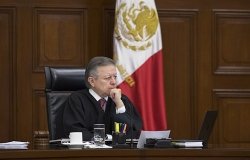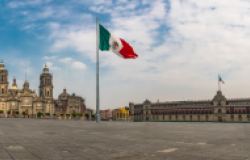The Global Stakes on Why Black Lives Matter

Wikimedia Commons. Creative Commons CC0 1.0 Universal Public Domain Dedication and Article § 59 of the German copyright law.
The United States and China are currently engaged in a complex relationship. While retaining important aspects of cooperation, it is increasingly characterized by rivalries that span multiple domains, including national security, trade, finance, advanced technologies, cyber, and space. Often minimized or overlooked, however, is an important ideological element to this competition.
Under the leadership of Xi Jinping, the Chairman of the Chinese Communist Party (CCP), China is asserting the superiority of its model of state-directed, managed authoritarianism over the U.S. model of individual liberty and representative democracy. China today is asking the world: “Which country’s system offers a better pathway to the future, China’s or America’s? Which model of governance offers its citizens a more prosperous and secure future?”
China is not seeking converts to its brand of socialism; instead, it is seeking a broader recognition of its ability to more efficiently deliver public goods to its citizens and more tangibly assist its friends and partners around the world. Implicit in this approach is Beijing’s expectation that countries will confer a measure of legitimacy on the CCP through admiration for its performance and accomplishments, not question or criticize its severe methods of internal governance and, ultimately, defer or acquiesce to its preferences.
This competition is today playing out against the broader context of the COVID-19 pandemic. The CCP’s claims to the benefits of one-party authoritarianism are highlighted by its far more coordinated and effective response to suppressing the virus and resuming normal economic and educational activities, as compared with America’s stumbling, disjointed and reactive response. As Xi boasted in mid-September, the CCP’s handling of the virus and restarting the economy “fully demonstrated the clear superiority of the Communist Party leadership and our socialist system.”
Further, the death of George Floyd at the hands of Minneapolis police, the Black Lives Matter (BLM) movement and ongoing protests across the United States have been used by China not only to highlight America’s failure to protect its citizens and live up to its claims of racial equality and social justice, but also to deflect criticism over Beijing’s actions in brutally suppressing dissent in Hong Kong. For example, after the posting of a critical tweet by State Department spokesperson Morgan Ortagus over a new national security law for Hong Kong, the Chinese Foreign Ministry mockingly responded, “I can’t breathe.” This has been part of a larger effort by China to use the civil rights protests and periodic outbreaks of vandalism and violence to shift the media focus away from an examination of China’s own human rights record.
It matters greatly whose model of governance prevails in this competition. An international system dominated by China promises to be less transparent, less accountable and less free. Unless individual rights and representative government are embraced, modeled and promoted by the world’s most powerful and influential country, it is doubtful they will prosper in the 21st century.
However sincere and deeply held our belief in the ultimate superiority of democracy over the CCP’s authoritarianism, its triumph is not self-fulfilling. Freedom’s victory is not so assured that we can discount or ignore how America’s ongoing national experiment in self-governance is perceived by the rest of the world. As the United States experiences widespread civil rights marches, fervent calls for racial justice, and demands for a fuller reckoning with its history, domestic politics and foreign policy are becoming more interconnected every day. Whether we rise to meet this moment, or fail to do so, will not only determine the quality of American democracy in the years to come, but will also influence whether democracy will flourish around the world.
We’ve been here before
This is not the first time that the United States has been faced with an ideological rival that highlighted racial injustice and civil unrest in the United States to assert the superiority of its system.
In the fall of 1957, the official media outlets of the Soviet Union, Pravda and Izvestia, published a series of blistering articles criticizing the violence and rioting surrounding the attempted desegregation of Central High School in Little Rock, Arkansas. With headlines like “Troops Advance Against Children!,” the articles stated that “fascist thugs of the Ku Klux Klan are organizing a savage hunt for Negro children” and “National guard soldiers and policemen armed to the teeth bar Negro children from entering the schools, threaten them with bayonets and tear-gas bombs and encourage hooligans to engage in violence with impunity….”
Genuine concern for the nine Black students trying to attend classes in Little Rock was not Moscow’s primary goal. Far more was at stake. These broadsides were the latest salvoes in an ongoing ideological competition with the United States over which form of government was more equitable, more respectful of its citizens and more attuned to their hopes and dreams for the future.
The intended target audiences were the billions of people in the newly decolonized and decolonizing countries of Africa, Asia and Latin America; collectively, more than two-thirds of the world were people of color. Highlighting America’s racial inequities and widespread denial of basic rights to its Black population was a useful way for Moscow to score propaganda points and win their political sympathies. The prize was these peoples and countries aligning with the socialist bloc against the United States and its allies and voting with Moscow in the United Nations and other international bodies.
U.S. officials understood the Soviet game plan and well appreciated the damage that racial discrimination, and the associated violence, exacted on American diplomacy and foreign policy goals. Fears that racial inequality at home was undermining America’s efforts to fight communism and promote democracy overseas had led Secretary of State Dean Acheson to weigh in on the 1954 landmark case, Brown v. the Board of Education. In an amicus curiae brief filed by the Justice Department, Acheson warned that “racial discrimination in the United States remains a source of constant embarrassment to this Government in the day-to-day conduct of its foreign relations; and it jeopardizes the effective maintenance of our moral leadership of the free and democratic nations of the world.”
According to Mary L. Dudziak—whose book, Cold War Civil Rights, remains the best treatment of that era’s interplay of domestic racial unrest and American foreign policy—the U.S. government did not try to deny the fact of racial discrimination. Instead, it told “a story of the triumph of good over evil, a story of US moral superiority…. American democracy was a form of government that made the achievement of social justice possible, and that democratic change, no matter how slow and gradual, was superior to dictatorial imposition.”
The vehicle through which America told its story to the world during this period was the United States Information Agency (USIA), which was a government funded and directed public relations organization embedded within the State Department. USIA issued official news releases and press bulletins, published favorable stories in local media, and broadcast news to 150 countries around the world. The State Department also sponsored foreign tours of prominent Americans, including academics, public intellectuals, and celebrities, who often spoke about race. Particularly popular was the cultural diplomacy embodied by the so-called “jazz ambassadors,” such as Duke Ellington and Louis Armstrong.
But, as Dudziak makes clear, these well-intended diplomatic efforts during the 1940s, 1950s and 1960s did not solve the underlying foreign policy problems posed by racial discrimination, nor did they rebut charges of American hypocrisy. Further, the State Department’s efforts were always at risk of being undermined by events that the U.S. government could not control, namely, the periodic outbreak of vicious racial violence against Black Americans. Only with the passage of the Civil Rights Act of 1964 and the Voting Rights Act of 1965 could the United States compellingly claim to have achieved tangible, meaningful and lasting progress in reconciling America’s actions with its founding principles, and redeeming the promise of equality in its Declaration of Independence.
Underpinning all of the efforts by the Truman, Eisenhower, Kennedy and Johnson administrations was a bedrock, bipartisan belief that “a decent respect to the opinions of mankind” mattered, that our embrace of human dignity and representative government was universally appealing, and that the spread of democracy would contribute directly to American peace and prosperity.
Is China winning?
According to Xi Jinping, China’s recent assertiveness is all part of a “new era…that sees China moving closer to center stage.” Under the banner of managed authoritarianism, the appeal of the Chinese Communist Party (CCP) is that it has delivered important benefits to its citizens, including jobs, education, housing, and rising living standards. These policies have helped lift hundreds of millions of people out of poverty over the past few decades.
The costs of its approach have been, most notably, the widespread repression of dissent or independence from the dictates of the CCP, and its control over peoples’ political expression and choices. Just this past summer, China contravened its agreement with Great Britain and unilaterally imposed an oppressive new national security law for Hong Kong and, earlier this year, the CCP rolled out a program that assigns each Chinese citizen a “social credit score” to indicate their political reliability, which will determine opportunities for education, work, and travel. In the last few years it has imprisoned more than a million Uighurs and suppressed their culture. China has also installed over 200 million CCTV cameras across the country to monitor the behavior of its citizens 24/7. Last year Freedom House cited China as the world’s worst abuser of internet freedom for the fourth consecutive year.
At the same time, the CCP is no longer limiting its thought control to the Chinese mainland. While the Chinese government has always been sensitive about its image and any perceived interference in its internal affairs, recently it has stepped up its “extraterritorial censorship” by threatening and punishing foreign firms that deviate from Beijing’s official line. Recent targets of this campaign include Delta, United and American Airlines, Marriott, major Hollywood studios, the Japanese retailer Muji, and most notably, the NBA after the General Manager of the Houston Rockets tweeted his support for anti-government protesters in Hong Kong.
Further, Beijing has been aggressively promoting its agenda at the United Nations and other international organizations. A 2020 study by the Center for a New American Security characterized the Chinese as “challenging what it perceives as a pro-Western status quo in international institutions and replacing it with new norms that (under the guise of improving technology) create more tolerance of government surveillance and censorship…China is successfully chipping away at liberal democratic norms governing the free flow of information and seeking to create a global information environment that is conducive to its state propaganda and information controls.” In short, China has become a “selective stakeholder” that is trying to institutionalize its managed authoritarian model as the new norm for global governance.
In addition, China has been creating alternative organizations that pointedly exclude the United States, as well as developing alternative financial architecture that seeks to diversify the international monetary system, including efforts to marginalize the U.S. dollar as the world’s reserve currency.
China’s ambitious effort at economic statecraft, its multibillion dollar “Belt and Road Initiative,” is designed to develop overland and maritime passages across Southeast Asia, Central Asia and South Asia to the Middle East, Africa and Europe. While China’s allocation of developmental capital has been welcomed by many countries, the financing of these projects does not follow the standard procedures and protections for states that receive World Bank loans. Many of these loans have already prompted a donor backlash by civil societies in the affected states, which cite fears of predatory lending, debt traps and corruption.
China’s growing assertiveness has been taking place at a time of particular vulnerability for democracies, when authoritarian, nativist and populist movements in Europe, Africa, Asia and Latin America have spread. According to Freedom House’s latest annual report, freedom around the world has been in retreat for the past fourteen consecutive years.
What can the U.S. do?
What lessons can America apply to China’s challenge today from its earlier ideological competition with the Soviet Union and especially from its experience with Moscow’s criticisms over race in the 1950s and 1960s?
Much has changed in the ensuing decades. Today, USIA no longer exists, having been legislated out of existence in 1999. In its place there is an Under Secretary of State for Public Diplomacy and Public Affairs, and USIA’s broadcasting functions have been outsourced to an independent Broadcasting Board of Governors. There is no simple or easy way for the State Department to coordinate its messages globally, and the explosion of digital sources of news and content over the past few decades threatens to drown out its voice.
Prominent Americans no longer need to be sponsored by the State Department to speak overseas; indeed, modern communications technology transports them digitally while never having to leave their living rooms. And while America’s soft power is propelled globally by its talented musicians, artists, television and film stars, and other celebrities, their popularity exists separately from our country’s politics and political divisions. They do not make or even influence U.S. domestic or foreign policy.
As Dudziak shows, it was only when the United States passed civil rights legislation that it could adequately rebut the Soviet Union’s assertions of racial discrimination and American hypocrisy. Similarly, if the U.S. wants to beat back China’s messaging and influence operations, then it will need to pass legislation that reasserts America’s commitment to racial and social justice. A short list would include extending and protecting voting rights, police and criminal justice reform, further steps to insulate our political process from foreign interference, and comprehensive immigration reform that balances humanitarian concerns with a strategy for attracting the skills and talent necessary for economic success in the 21st century.
The Black Lives Matter movement and civil rights protests across the country have greatly heightened public awareness of racial inequality, but how the United States government responds to these calls for racial and social justice will define how we are viewed around the world. Public and private institutions have been issuing statements of solidarity, which should be welcomed. But the far more difficult challenge is to translate expressions of goodwill by public officials, corporate CEOs, academic leaders, and others into tangible, measurable and sustainable progress. The United States has an opportunity to have a fuller reckoning with our past, and merge history and hope into a fairer and more equitable society for all Americans. The whole world is watching.
*Mitchell B. Reiss is a Distinguished Fellow at the Woodrow Wilson International Center for Scholars. Claudia Coscia is a Research Assistant at the Wilson Center and a student at American University.
About the Authors

Mitchell Reiss
Ambassador (retired); Former President and CEO, Colonial Williamsburg Foundation
Claudia Coscia

Kissinger Institute on China and the United States
The Kissinger Institute works to ensure that China policy serves American long-term interests and is founded in understanding of historical and cultural factors in bilateral relations and in accurate assessment of the aspirations of China’s government and people. Read more











